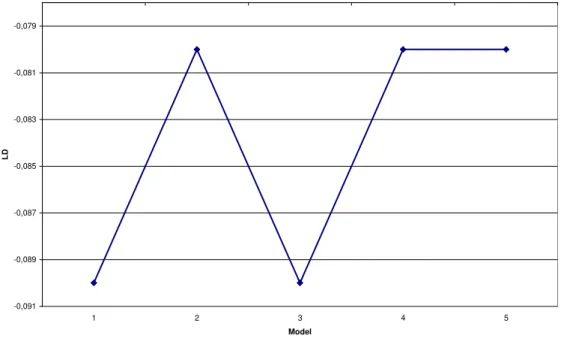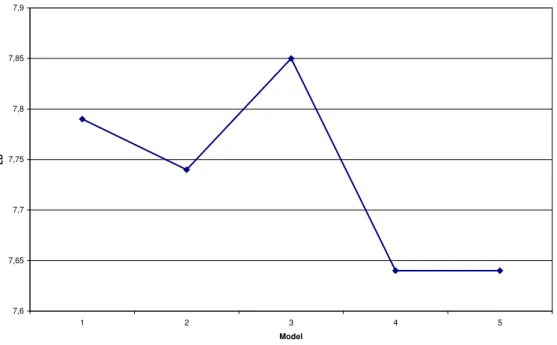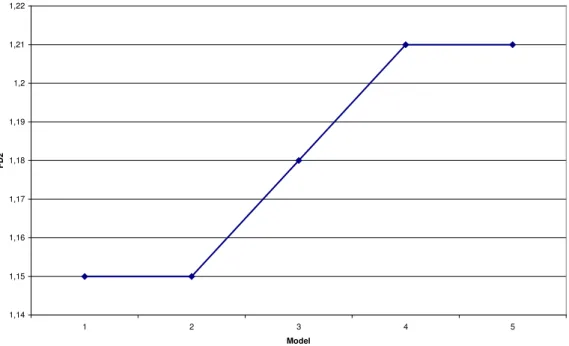ISSN 1330-7142 UDK =636.4:636.082.4
EFFECT OF INBREEDING ON LOIN AND FAT DEPTH IN HUNGARIAN
LANDRACE PIGS
Zsófia Vígh (1), P. Gyovai (1), L. Csató (1), Á. Bokor (2), J. Farkas (3), I. Nagy (1)
Preliminary communication
SUMMARY
Pedigree and field test data - collected between 1997-2005 - were analyzed in a group of 68062 Hungarian Landrace pigs. The analysed traits were loin depth (LD), fat depth1 (FD1) and fat depth2 (FD2). In the present study inbreeding coefficients, pedigree completeness (complete generation equivalents) and inbreeding depression for LD, FD1 and FD2 were estimated. Increasing number of generations that were considered in the pedigree the estimated inbreeding coefficients did not change after the 5th generation, but pedigree completeness was continuously increasing. The estimated inbreeding depression for LD, FD1 and FD2 were different applying 5 different models but the magnitude of the differences was small. Increasing inbreeding coefficient by 10% caused LD decrease by 0.084 mm, the FD1 by 0.062 mm and did not affect FD2. It can be concluded that the estimated inbreeding depression was low and substantial depression can not be expected in the near future. However, the low level of inbreeding of the studied population can partly be explained by the short pedigrees. This suggests that Hungarian pig breeders may often import breeding animals or carry out herd replacements rather than apply within group selection.
Key-words: pig, inbreeding coefficients, pedigree completeness, inbreeding depression
INTRODUCTION
One of the disadvantageous effects of inbreeding is the reduction of the mean phenotypic value of a trait known as inbreeding depression. Numerous authors experienced inbreeding depression in different domesticated (Miglior et al., 1995; Wiener et al., 1992; Horn and Meleg, 2000; Curik et al., 2003), wild, (Hedrick and Kalinowski, 2000), captive (non-domesticated) (Cassinello, 2005) and experimental (White, 1972) populations. Inbreeding depression is mainly apparent in traits closely related to fitness (Falconer and Mackay, 1996), but the reduction is not confined to reproductive traits. The negative effects of inbreeding are magnified by the fact that they often affect several traits (such as litter size at birth, mortality during the suckling period, litter weight at 21 days of age) simultaneously and are operating through litters and through dams. The inbreeding depression in domesticated species is mainly important because it affects production efficiency. The National Institute for Agricultural Quality Control has been collected pedigree and field test data of the Hungarian Pig populations for many years which is evaluated routinely with linear (animal) models. However, extensive study on the pedigree based inbreeding level and the inbreeding depression for the collected traits has not yet been accomplished. The objective of this study was, therefore, to estimate the level of inbreeding of the Hungarian Landrace population and inbreeding depression for the collected field test traits, namely loin depth (LD), fat depth1 (FD1) and fat depth2 (FD2).
MATERIAL AND METHODS
_________________________
(1)Zsófia Vígh, Ph.D. student; Petra Gyovai, gradual student; Ph.D. László Csató, Associate Professor; István
Data recording
The analysis was conducted on the data collected by the National Institute for Agricultural Quality Control of Hungary between 1997 and 2005, in the course of field test. Data of 68062 Hungarian Landrace pigs reared in 26229 litters were analyzed, originated from 63 herds. In the field test ultrasonic measurements were taken from boars and gilts between 80 and 110kg. The measured traits were the loin muscle depth between the 3rd and 4th ribs 6cm laterally from the spinal chord (LD), the
fat depth between the 3rd and 4th lumbar vertebrae 8cm laterally from the spinal chord (FD1), and the
fat depth between the 3rd and 4th
Traits
ribs 6cm laterally from the spinal chord (FD2). Gilts were kept in groups up to 25 pigs while boars were raised in smaller groups up to 15 using ad libitum feeding regime (OMMI, 2004). Basic statistics of the field test data are presented in Table 1.
Table 1.Mean and standard deviation of the loin depth, fat depth1 and fat depth2
No. of records Mean St. dev.
LDa 68062 45.74 6.05
FD1b 68062 12.90 3.23
FD2c 68062 11.22 2.78
aLD, loin depth; bFD1, fat depth1; c
∑ ∑
= = N j n i g j ijN
1 12
1
1
FD2, fat depth2
Pedigree analysis
The total number of animals in the pedigree was 74914. Data analysis was started with pedigree analysis using the PEDUTIL, NGEN and VANRAD softwares. The first step was accommodating the pedigree data according to the animals with field test records using the PEDUTIL program. Pedigree completeness for every individual was assessed by formula of Boichard et al. (1997):
where N is the number of animals in the reference population, nj is the total number of ancestors of
animal j and gij is the number of generations between j and its ancestor i.
Pedigree completeness was assessed by tracing back the pedigree for three, four, five, six and seven generations. (pc3-pc7
Inbreeding coefficient was assessed by tracking back the pedigree of three, four, five, six and seven generations. (F
). Inbreeding coefficient (F) (Wright, 1922) was calculated of each individual using VANRAD program.
3-F7). The applied programmes are all a part of the PEDIG software package
(Boichard, 2002). After these calculations the results from pedigree analysis were joined with the field test records (PROC MERGE, SAS Institute Inc., 2004).
The differences between the number of generations (pedigree completeness and inbreeding coefficients) were tested with PROC ANOVA (SAS Institute Inc., 2004) using repeated measurements.
Genetic parameters estimation
4 - X X X X X X X
5 X X X X X X X
The basic linear model was as follows:
y = Xb + Za + Wc + e
where y = vector of observations, b = vector of fixed effects, a = vector of random animal effects, c = vector of random litter effects, e = vector of random residual effects,
X, Z, W, are incidence matrices relating records to fixed effects, random animal and random litter effects, respectively. Body weight measurements, inbreeding coefficients (F) and pedigree completeness (pc) were defined as covariates, herd or herd-year, sex and year-month or month effects were defined as fixed effects, litter and animal effects were defined as random effects in the model. Inbreeding depression (the BLUE estimate of F) referring to the analyzed period was determined for LD, FD1 and FD2. Five models applied were compared by their mean squared error (MSE) using the PREDICT option of the PEST software.
RESULTS AND DISCUSSION
Figure 2. Distribution of inbreeding coefficients tracking back 3 and 7 generations
-0,091 -0,089 -0,087 -0,085 -0,083 -0,081 -0,079
1 2 3 4 5
Model
LD
Figure 3. The estimated inbreeding depression for LD
-0,071 -0,069 -0,067 -0,065 -0,063 -0,061 -0,059
1 2 3 4 5
Model
F
D1
Figure 4.The estimated inbreeding depression for FD1
7,6 7,65 7,7 7,75 7,8 7,85 7,9
1 2 3 4 5
Model
LD
Figure 5. Mean square errors of the applied models for loin dept
1,74 1,75 1,76 1,77 1,78 1,79 1,8 1,81 1,82 1,83 1,84
1 2 3 4 5
Model
F
D1
1,14 1,15 1,16 1,17 1,18 1,19 1,2 1,21 1,22
1 2 3 4 5
Model
F
D2
Figure 7.Mean square errors of the applied models for fat depth2
Involving the continuous generations the accuracy of the estimation was not improved probably because of the very short pedigrees.
CONCLUSION
It can be concluded that due to the low inbreeding level and small inbreeding depression of LD, FD1 and FD2, substantial depression can not be expected in the Hungarian Landrace in either trait in the near future. Nevertheless because field test data was available for a 12 year period, the estimated pedigree completeness was very low compared to the possible value (3-4) supposing more complete pedigrees. The absolute level of inbreeding of any animal depends on its pedigree length. Animals with long pedigree had higher probability of being inbred. Thus the negligible inbreeding depression was presumably partly the result of the short pedigrees. This suggests that conventional within group selection in the Hungarian Landrace nucleus farms has only secondarily importance. Pig breeders likely often import breeding animals or from time to time accomplish total herd replacements.
ACKNOWLEDGEMENT
Financial support of NKFP-4/057/2004 is gratefully acknowledged.
REFERENCES
6. Curik, I., Sölkner, J., Stipic, N. (2001): The influence of selection and epistasis on inbreeding depression estimates. J Anim. Breed. Genet., 118:247-262.
7. Curik, I.; Zechner, P.; Sölkner, J.; Achmann, R.; Bodó, I.; Dovc, P.; Kovar, T.; Marti, E.; Brem, G. (2003): Inbreeding, Microsatellite Heterozygosity, and Morphological Traits in Lipizzan Horses. J. Hered., 94:125-132.
8. Dickerson, G.E., Blunn, C.T., Chapman, A.B., Kottman, R.M., Krider, J.L., Warwick, E.J., Whatley, J.A. Jr. (1954): Evaluation of selection in developing inbred lines of swine. Res. Bul. Mo. Agric. Exp. Sta. No. 551:60pp.
9. Falconer, D.S., Mackay, T.F.C. (1996): Introduction to quantitative genetics. 4th
10. Groeneveld, E. (1990): PEST Users’ Manual. Institute of Animal Husbandry and Animal Behaviour Federal Research Centre, Neustadt, Germany, 1-80.
Ed. Longman, Harlow 464.
11. Hedrick, P.W., Kalinowski, S.T. (2000): Inbreeding depression in in conservation biology. Annu. Rev. Ecol. Syst., 31:139-162.
12. Hitoshi , M., Freeden, H.T., Sather, P. (1977): Mass selection in a pig population. 2. The effects of inbreeding within the selected populations. Can. J. Anim Sci. 57:627-634.
13. Horn, P., Meleg, I. (2000): Inbreeding effects on production traits in pigeons. Arch. Geflugelkd., 64:273-277.
14. King, J.W.B., Roberts, R.C. (1959): The effects of inbreeding on carcass traits in the bacon pig. Anim. Prod., 1:123-127.
15. Kovac, M., Groeneveld, E. (2003): VCE-5 Users’ Guide and Reference Manual Version 5.1. University of Ljubljana, Biotechnical Faculty, Department of Animal Science, Domzale, Slovenia. Institute of Animal Science Federal Agricultural Research Centre, Neustadt, Germany, 1-68. 16. Miglior, F., Burnside, E.B., Kennedy, B.W. (1995): Production traits of Holstein cattle: estimation
of nonadditive genetic variance and inbreeding depression. J. Dairy Sci., 78:1174-1180.
17. OMMI (National Institute for Agricultural Quality Control). (2004): Pig performance Testing Code. 5th
18. SAS Institute Inc. (2004): SAS/STAT edition, Budapest, 1-101.
19. White, J.M. (1972): Inbreeding effects upon growth and maternal ability in laboratory mice. Genetics, 70:307-317.
9.1 User’s Guide. Cary, NC, USA
20. Wiener, G., Lee, G.J., Woolliams, J.A. (1992): Effects of rapid inbreeding and crossing of inbred lines on the body weight growth of sheep. Anim. Prod., 55:89-99.



